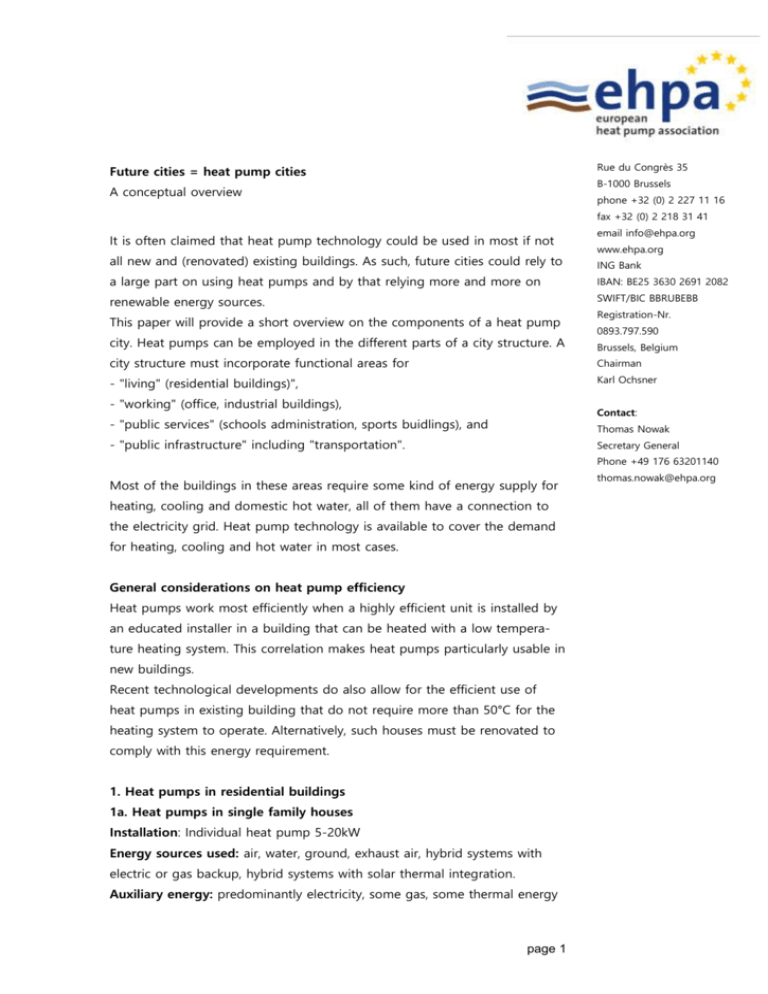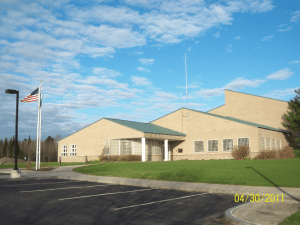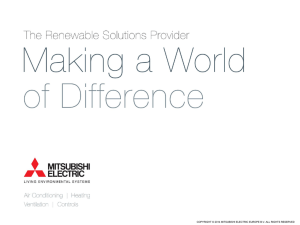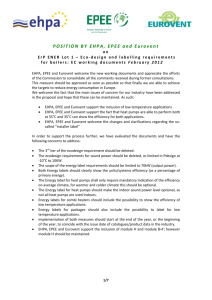2010 future cities = heat pump cities
advertisement

Rue du Congrès 35 Future cities = heat pump cities B-1000 Brussels A conceptual overview phone +32 (0) 2 227 11 16 fax +32 (0) 2 218 31 41 It is often claimed that heat pump technology could be used in most if not all new and (renovated) existing buildings. As such, future cities could rely to email info@ehpa.org www.ehpa.org ING Bank a large part on using heat pumps and by that relying more and more on IBAN: BE25 3630 2691 2082 renewable energy sources. SWIFT/BIC BBRUBEBB This paper will provide a short overview on the components of a heat pump city. Heat pumps can be employed in the different parts of a city structure. A Registration-Nr. 0893.797.590 Brussels, Belgium city structure must incorporate functional areas for Chairman - "living" (residential buildings)", Karl Ochsner - "working" (office, industrial buildings), Contact: - "public services" (schools administration, sports buidlings), and Thomas Nowak - "public infrastructure" including "transportation". Secretary General Phone +49 176 63201140 Most of the buildings in these areas require some kind of energy supply for heating, cooling and domestic hot water, all of them have a connection to the electricity grid. Heat pump technology is available to cover the demand for heating, cooling and hot water in most cases. General considerations on heat pump efficiency Heat pumps work most efficiently when a highly efficient unit is installed by an educated installer in a building that can be heated with a low temperature heating system. This correlation makes heat pumps particularly usable in new buildings. Recent technological developments do also allow for the efficient use of heat pumps in existing building that do not require more than 50°C for the heating system to operate. Alternatively, such houses must be renovated to comply with this energy requirement. 1. Heat pumps in residential buildings 1a. Heat pumps in single family houses Installation: Individual heat pump 5-20kW Energy sources used: air, water, ground, exhaust air, hybrid systems with electric or gas backup, hybrid systems with solar thermal integration. Auxiliary energy: predominantly electricity, some gas, some thermal energy page 1 thomas.nowak@ehpa.org from other sources (for cooling). Examples: Individual single-family houses, nearly unlimited design options, energy, low temperature heating and good insulation very important! 1b. Heat pumps in multi-family houses Heat pumps in multi-family buildings are larger in size - depending of the size and energy demand of the building. Apart from this fact, they can be employed like those mentioned in point 1a. Installation: Individual heat pump 20 to 50kW, one or several units possible for cascading use. Energy sources used: air, water, ground, exhaust air Examples: multi-family houses, row house or high rise, nearly unlimited design options, energy, low temperature heating and good insulation very important! Predominantly equipped with central heating system, some examples with a brine circulation line and individual small heat pumps per appartment exist. 2. Heat pumps in office and commercial buildings A wide range of applications exist for heat pump use in office building depending on their requirements. Heat pumps are often used for heating and cooling. Installation: Individual heat pump up to 20 kW to 1MW, one or several units possible for cascading use. Energy sources used: air, water, ground, exhaust air Examples: - Hotels - Office buildings - Farms, Dairy production - Swimming pools 3. Industrial use of heat pumps In industrial applications heat pumps can be used to provide process heat and to provide heating, cooling and hot water. 4. Heat pumps in public buildings European Heat Pump Association | Rue du Congrès 35 | B-1000 Brussels page 2 The use of heat pumps in public buildings is identical to that in office buildings. 5. Heat pump use in and for infrastructure Public infrastructure such as subway systems or sewage systems can serve as heat sources for heat pumps. Several examples exists in which the concrete used for the construction of theses systems is thermally activated. Average temperature in such systems is approx. 10°C which can efficiently be used to heat nearby buildings. A so-called cold source can be used as a distribution grid for energy to heat pumps and is in itself a piece of public infrastructure. As opposed to a district heating system which operates at high temperature, a "cold source" is operating at rather low temperatures (10°C to 20°C) and requires little or no insulation. It delivers energy between its users and can be used for cooling in summer and for heating in winter. When used for cooling, it servers as a storage for excess heat from industrial use, solar thermal collectors etc.. The energy entered can taken from the source at a different location via heat pumps. Examples: Sewer system City of the hague, where a cold-source grid connects approx. 350 homes with 10°C water. Individual houses are equipped with heat pumps that run efficiently with 10°C. 6. Heat pump applications in transport As mentioned in item 5, metro tunnels or street tunnels could be used as energy sources for heat pumps. New electric cars can use heat pumps as they lack waste heat that is used for heating in conventional cars. Example: Audi e Excurse: Heat source for geothermal applications Heat sources for geothermal heat pumps can be horizontal pipes or vertical European Heat Pump Association | Rue du Congrès 35 | B-1000 Brussels page 3 drillings, trenches or wells. In larger construction, where several supporting concrete foundations are necessary, these concrete piles can be thermally activated thus transporting the heat from the ground to the heat pump (heating mode), or the heat from the building to the underground (cooling mode). Similarly, underground parking garages or basement structures can be used. European Heat Pump Association | Rue du Congrès 35 | B-1000 Brussels page 4








